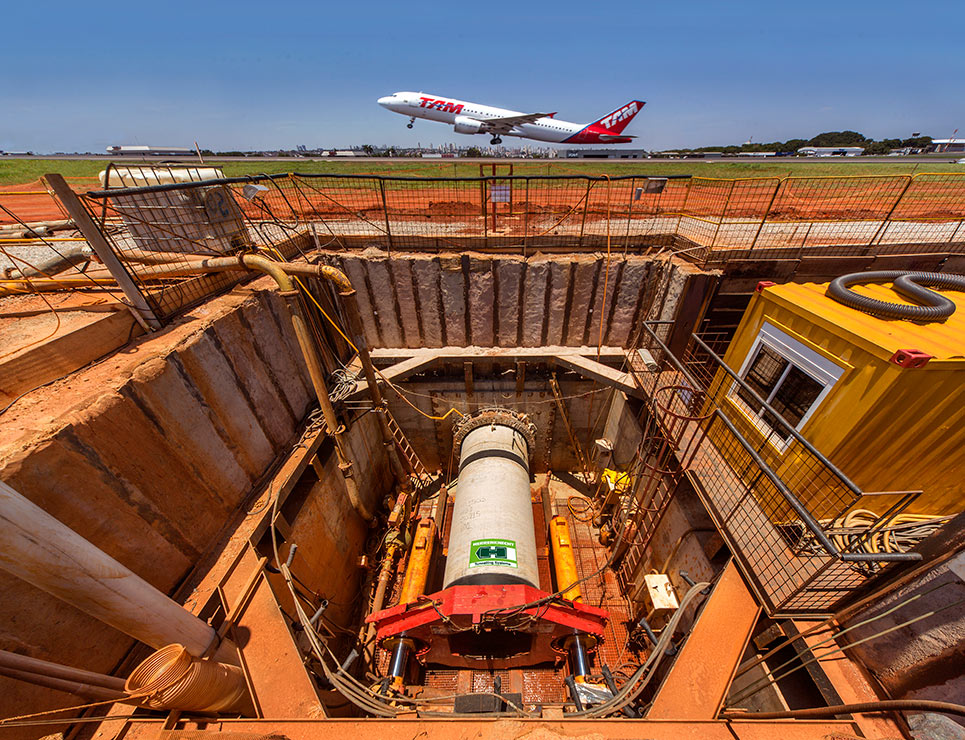Precision required for airport excavations 08 Aug 2019
Driving under the taxiway of the third busiest airport in the world posed significant challenges. It was achieved successfully by a Herrenknecht 3m diameter AVN pipejacking machine under Dubai International Airport for a drainage project. It is the latest in a list of airport-based projects for the German manufacturer going back to the early 2000s, involving both small-bore AVN machines, as well as larger-diameter TBMs.
“The general challenge for projects under airport taxiways and runways is for a quick, safe and vibration-sensitive underpass without interrupting flight operations,” explained Herrenknecht. “Heave, settlement or other impairment of this sensitive infrastructure must be avoided. Passenger safety cannot be compromised. This calls for surgical precision, especially at larger diameters.”
Herrenknecht TBMs include several technologies to reliably and precisely cut through all geologies, including heterogeneous ground conditions. These include high-pressure water cleaning systems to clean the cone crusher in micro machines and reduce the risk of clogging, particularly in cohesive soils. In addition, the VMT-supplied UNS, universal navigation system, uses various gyro and electronic water-levelling systems to enable precise guidance, particularly on curved alignments.
Micro machines, such as the AVND2400AB used at Dubai International Airport, pose the additional challenge of the inability to access the cutterhead. To counter this, Herrenknecht has developed an additional door behind the cutterhead to allow safe man entry through an airlock.
Herrenknecht AVN are “all-rounders for tunnelling in diameters between 400mm to about 4m. The slurry-supported excavation makes it possible to use these machines in ground conditions, ranging from silt to clay, gravel and hard rock, using both pipejacking and segmental lining depending on diameter.”
At the Dubai International Airport, the AVND2400AB excavated three drives of 610m, 765m and 825m for a new stormwater project through sandstones and siltstones at up to 13m – 15m deep. On the longest drive, an average of 15m/day was achieved. International Foundation Group was the tunnelling subcontractor for main contractor, MA Kharafi & Sons. The project is part of the Phase 3 expansion for Dubai Aviation Engineering Projects Corporation.
Another AVN machine, an AVN1500, constructed a 367m stormwater drain under the runway at Goiânia Airport in Brazil in 2015. Successful excavation was carried out during airport operation.
Larger-diameter projects have included the use of a 6.28m diameter Mixshield for the extension of the baggage handling system at Zurich Kloten Airport in 2001. The 2.4km long drive under the airport cut through alternating geological beds. The compressed air cushion of the Mixshield allowed for controlled excavation without causing disturbance to airport operations.
A year later, in 2002, a 6.46m diameter EPBM worked under Minneapolis-St Paul Airport in the USA for a light rail transit project. The twin 2.2km drives passed through a range of conditions, including soft and heterogeneous ground, coarse alluvium, limestone and sandstone. The project also required settlement and vibration sensitive work under the runways during flight operations.
More recently, in 2017, two 6.25m diameter EPBMs completed twin tubes for passenger and baggage transport at Moscow Sheremetyevo Airport in Russia. The excavation totalled 3.8km under the runways through soft ground comprising fine to medium sand, clay and marl. “The excavation of the soil and the lining of the tubes with concrete segments was carried out without heave, settlement or damage to the runways,” reported Herrenknecht at the time.
References
- TBMs accepted for the Dubai stormwater drives – TunnelTalk, August 2018
- Central information system provides big picture – TunnelTalk, January 2010
- Micro water supply drives for Strasbourg – TunnelTalk, May 2018
- Pipe-jacking for drainage channel in Germany – TunnelTalk, March 2018
- First curved micro drive in the USA – TunnelTalk, June 2010
|
|
|
|
|
Add your comment
- Thank you for taking the time to share your thoughts and comments. You share in the wider tunnelling community, so please keep your comments smart and civil. Don't attack other readers personally, and keep your language professional.






